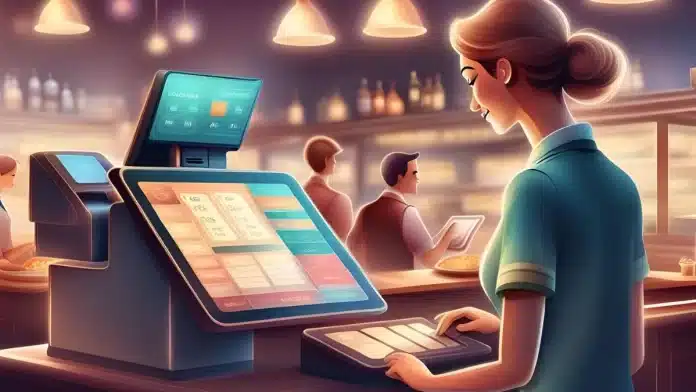Restaurant POS (Point of Sale) systems are revolutionizing the industry by enhancing restaurants’ operations and elevating the overall dining experience.
HashMicro’s Restaurant POS System provides a cutting-edge solution tailored to streamline your operations and optimize workflows. With features like real-time sales tracking, seamless inventory integration, and automated reporting, HashMicro empowers restaurant owners to enhance customer satisfaction, boost profits, and stay ahead in a competitive market
What is the Best Restaurant POS System in the Philippines?
The best restaurant POS providers for 2025 are:
- HashMicro: AI-powered, automated POS for all restaurant types.
- Shopify: Seamless integration for dine-in and online orders.
- Square: Affordable, easy-to-use POS for startups.
- Clover: Flexible POS with tailored restaurant features.
- SpotOn: Built-in loyalty, marketing, and ordering tools.
- StoreHub: Cloud-based POS with real-time analytics.
- Lightspeed: Optimized for quick-service and busy restaurants.
- UTAK: Budget-friendly POS with local support.
- Toast: Tableside ordering and menu customization.
- Lavu: iPad-based POS for food trucks & pop-ups.
- Revel Systems: Multi-location management for large chains.
- TouchBistro: Simple interface designed for restaurants.
- EPOS Now: Cloud-based POS for growing businesses.
- CAKE: Fast and efficient order processing.
Key Takeaways
|
Table of Contents
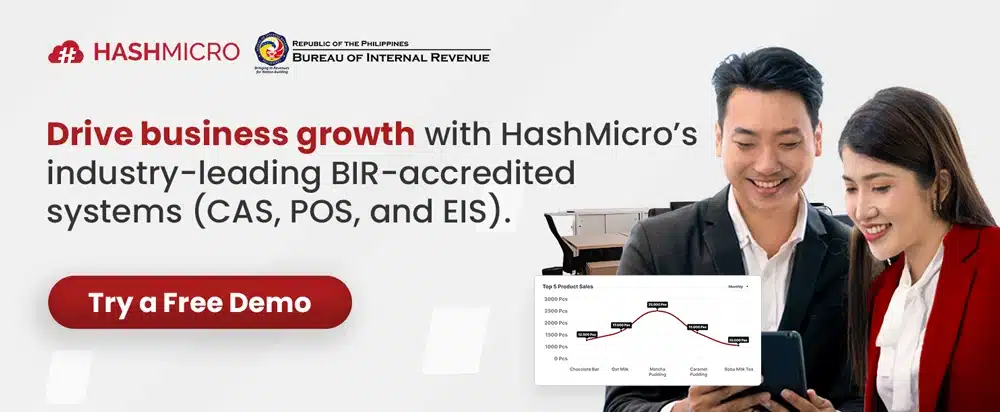
What is a Restaurant POS System?
Restaurant POS system is software to manage sales transactions, track orders, process payments, and integrate various operational functions like inventory and customer management. It streamlines kitchen and front-of-house operations, allows staff to input orders, and processes payments.
Modern restaurant POS systems are often cloud-based, offering real-time access and integration with other digital tools, making them essential for the smooth and profitable running of contemporary POS system restaurant businesses.
Need to know!
With Hashy AI from HashMicro, businesses can easily handle remote orders, on-site collection, delivery management, promotions, and multiple branches from one platform.

Get a Free Demo Now!
Different Types of POS
Here’s an overview of the different types of Point of Sale (POS) systems:
1. Traditional POS Systems
These are standard cash register systems typically found in retail stores and restaurants. They consist of hardware (like registers and barcode scanners) and software to process sales, manage inventory, and generate reports.
2. Mobile POS (mPOS)
Mobile POS systems use smartphones or tablets to process transactions. They are highly portable and often equipped with card readers, making them ideal for businesses that require mobility, such as food trucks or outdoor markets.
3. Cloud-Based POS
Cloud-based restaurant POS billing software store data online, allowing access from any device with internet connectivity.
This flexibility is beneficial for businesses with multiple locations, enabling centralized sales and inventory management. This is particularly advantageous for a POS system for restaurants in several areas.
4. Self-Service Kiosks
Self-service kiosk allow customers to place orders and make payments independently, reducing wait times and freeing up staff for other tasks. They are commonly found in fast-food restaurants and retail stores.
5. eCommerce POS
Integrated with online stores, these systems manage both online and offline sales. They streamline inventory management and provide a cohesive view of customer data across platforms.
6. Industry-Specific POS
Designed for specific sectors (like restaurants, salons, or gyms), these systems come with tailored features to meet unique operational needs, such as table management for POS restaurant system or appointment scheduling for salons.
14 Best Restaurant POS Systems: Reviews
Choosing the right restaurant POS system is crucial for the smooth operation of any business.
Here, we’ve compiled a list of restaurant POS systems that stand out in various aspects, including options for the restaurant POS Philippines market.
Let’s explore the best options available and why they could be ideal for your business.
1. HashMicro Restaurant POS
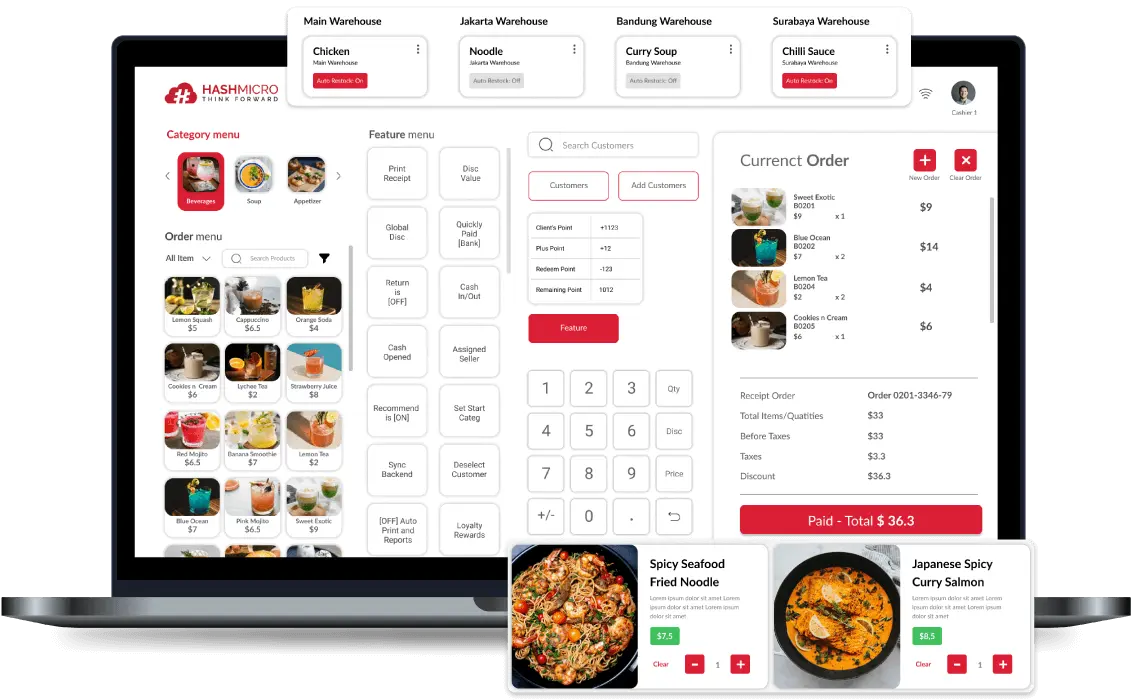
With more than 2,000 clients, especially in Southeast Asia, HashMicro is one of the leading providers of Point of Sales (POS) systems, renowned for its comprehensive and user-friendly solutions tailored for the restaurant industry.
Leveraging advanced technology and innovative features, HashMicro’s POS system is designed to streamline restaurant operations, enhance customer service, and boost overall efficiency.
HashMicro’s POS system enhances customer experience through table management, loyalty programs, and customizable menu options.
Here are some of the features that the HashMicro POS System offers:
- Multi-Payment Method: A multi-payment method feature in a POS system allows businesses to accommodate various payment preferences from customers, enhancing convenience and sales opportunities.
- Inventory tracking: A critical feature that enables businesses to monitor and manage their stock levels in real-time.
- Customer and promotion management: This feature helps businesses build and maintain strong customer relationships while driving sales through targeted marketing efforts.
- Easy billing and reconciliation: Streamline the process of billing customers and balancing accounts at the end of the day.
- Centralized multi-branch POS: Allows businesses with multiple locations to manage all their POS systems from a single, centralized platform.
- Comprehensive reporting: Offers detailed insights into various aspects of the business, aiding in informed decision-making.
| Strengths | Weaknesses |
|
|
If you want to learn more about how the HashMicro POS system can work for your restaurant and fulfill your needs, click the banner below!
2. Shopify
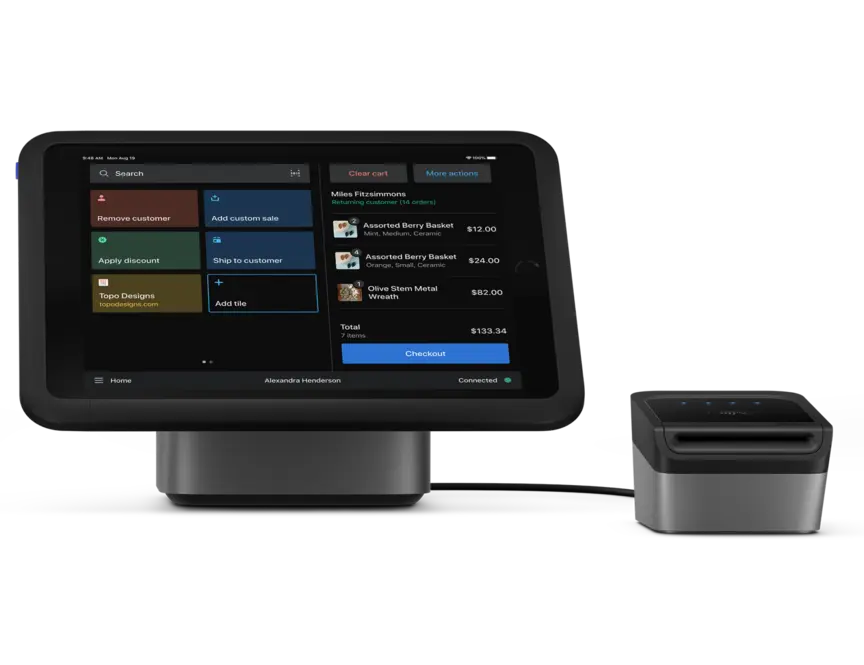
Shopify Point of Sales (POS) is a system that enables businesses to merge their online and offline sales seamlessly, thereby increasing sales and revenue.
However, while POS system Philippines by Shopify offers many benefits, there are a few notable drawbacks. One significant con is the lack of a free version, which can be a barrier for small or budget-conscious businesses.
Additionally, while Shopify’s advanced features and customization options are powerful, they can be expensive, potentially placing them out of reach for smaller establishments.
Best for: Quick-service and fast casual restaurants, cafés and bakeries, as well as multi-location chains.
Who shouldn’t use: Highly customized culinary services and fine dining restaurants with minimal takeout or delivery.
Pricing: From $29 USD – $299 USD per month (billed annually).
Here are some of the Shopify’s restaurant POS features:
- Hardware Customization: Shopify allows users to customize their hardware, including printers and scanners, to meet their business needs.
- Inventory Management: The system provides effective real-time inventory management tools to track product stock levels, ensuring product availability.
- Customer Loyalty Management: Shopify offers features to manage customer loyalty programs, helping businesses build stronger customer relationships.
- Business Reporting: The business reporting feature provides detailed insights into sales performance and operations, enabling better decision-making.
| Strengths | Weaknesses |
|
|
3. Square
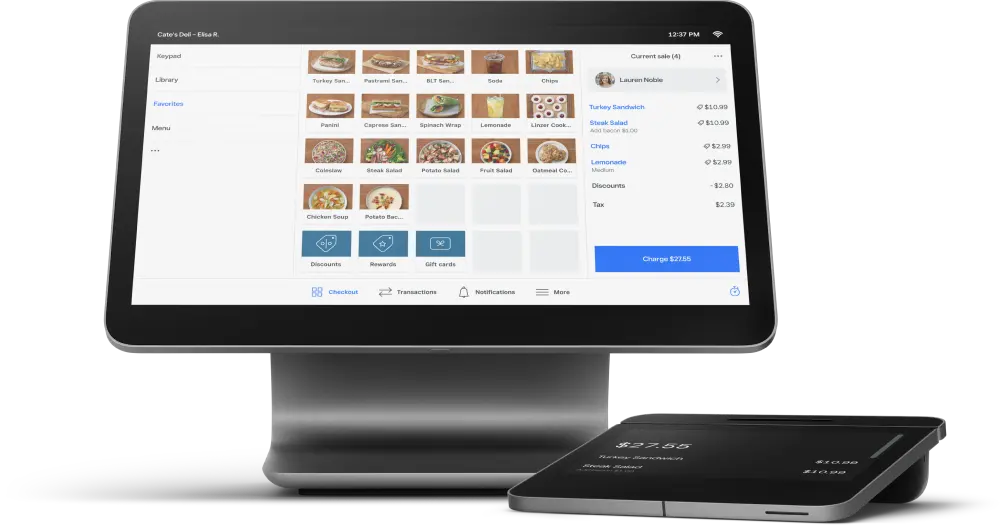
Square is a point of sale (POS) system known for its versatility and ease of use in various industries, especially in food service.
The primary advantages of Square include its affordability and ease of setup, making it accessible for businesses with limited budgets and technical expertise. The user-friendly interface and intuitive design allow quick onboarding and efficient daily operations.
However, some potential drawbacks are the transaction fees, which can add up for high-volume businesses, and the limited customization options compared to more specialized restaurant software.
Best for: Vendors starting without upfront costs, single-location businesses like food trucks, cafes, or kiosks, and those integrating an online store.
Who shouldn’t use: Restaurants with frequent floor plan changes, managers tracking ingredient usage, or those needing cost management tools.
Pricing: Basic plan is free and premium plan starts from $69/month.
Square’s restaurant POS offers the following features:
- Employee Management: Square provides tools for managing employee schedules, tracking attendance, and overseeing labor costs to streamline workforce management.
- Inventory Management: The system includes robust inventory management capabilities, allowing businesses to track stock levels sales data, and make adjustments as needed.
- Sales Analytics: Square POS offers comprehensive sales analytics, providing insights into sales performance, trends, and customer purchasing behavior to inform business decisions.
| Strengths | Weaknesses |
|
|
4. Clover
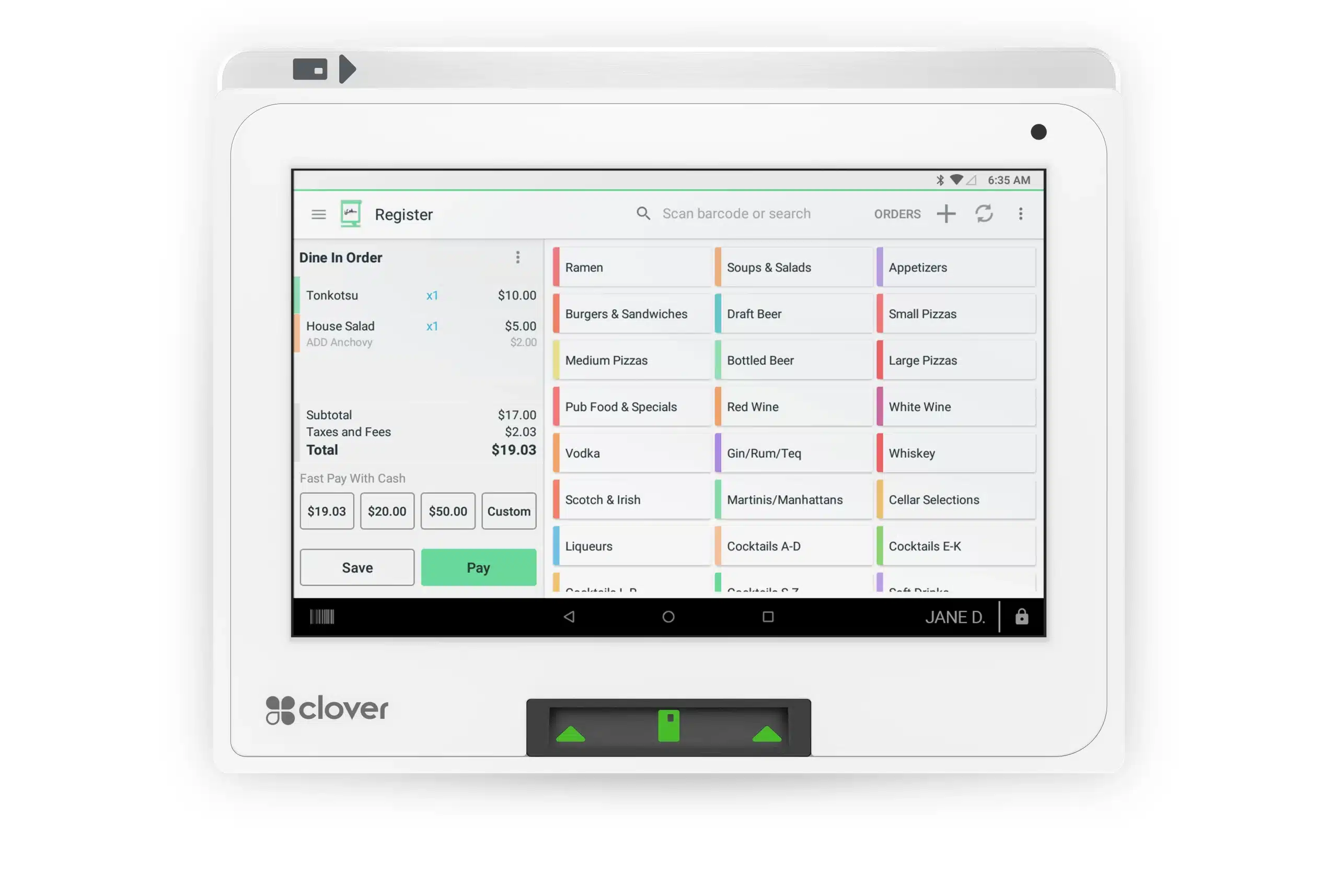
Clover offers an all-in-one solution that integrates sales processing, inventory management, employee management, and detailed reporting.
Its cloud-based platform ensures that business data is securely stored and accessible from any device, enabling real-time updates and remote management.
However, some potential drawbacks include occasional bugs and software glitches, which can disrupt operations and require time for troubleshooting. The cost can be higher than other POS systems, especially when adding hardware and app integrations.
Best for: Medium to large establishments, businesses focused on customer retention, and those seeking industry-leading hardware.
Who shouldn’t use: Small businesses or pop-up vendors, those wanting to avoid expensive upfront costs, or businesses needing tip-sharing tools.
Pricing: $59.95 per month
Below are some of the Clover’s restaurant POS features:
- Employee Management: Clover includes features for managing employee schedules, tracking hours worked, and handling payroll efficiently.
- Customer Engagement Tools: The system provides tools for enhancing customer engagement through loyalty programs, promotions, and targeted marketing campaigns.
- Hardware Customization: Clover allows businesses to customize their hardware setup with various options tailored to their specific operational needs.
| Strengths | Weaknesses |
|
|
5. SpotOn
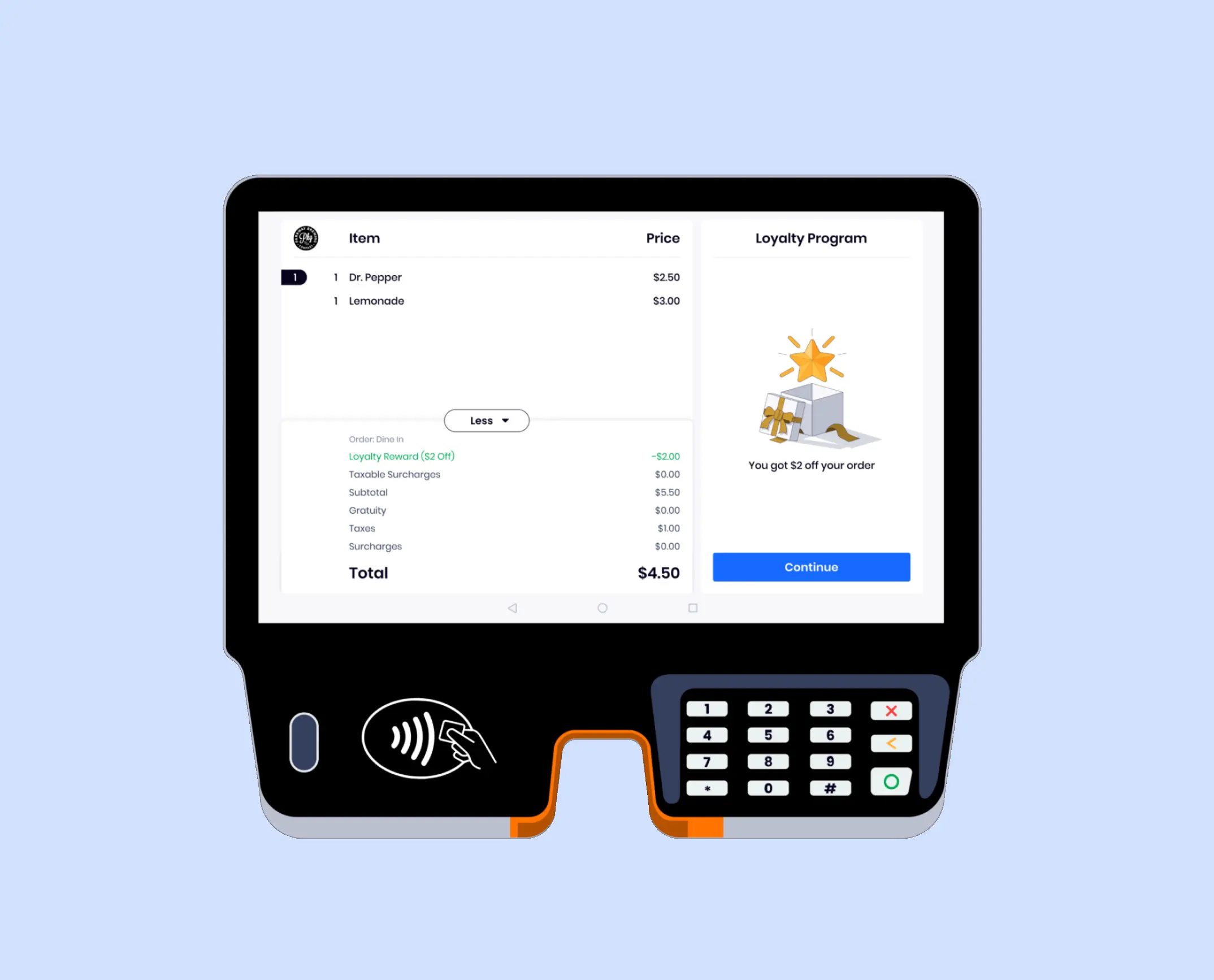
SpotOn Restaurant is a mobile POS system hosted in the cloud, tailored to assist small to medium-sized businesses within the hospitality sector in enhancing efficiency in online transactions, tableside ordering, and preventing fraud.
Additionally, occasional glitches within the system have been reported, which can disrupt operations and lead to frustrations. Furthermore, users have encountered challenges with system upgrades, which can result in interruptions and delays in service.
Best for: Vendors starting without upfront costs, busy establishments with large teams, and managers seeking to streamline employee processes.
Who shouldn’t use: Micro businesses needing a tablet-based system, restaurants with frequently changing floor plans, or owners wanting to purchase additional POS accessories.
Pricing: From $99 per month (hardware + software kit)
These are a few of the SpotOn’s restaurant POS features:
- Marketing Tools: SpotOn includes marketing capabilities that help businesses create and manage promotional campaigns to attract customers.
- Customer Data Analysis: The system provides tools for analyzing customer data, helping businesses understand purchasing patterns and preferences.
- Engagement Tracking: SpotOn offers features to track customer engagement across various channels, enabling businesses to refine their strategies.
- Loyalty Program Integration: The software integrates loyalty programs to reward repeat customers and encourage brand loyalty.
| Strengths | Weaknesses |
|
|
6. StoreHub
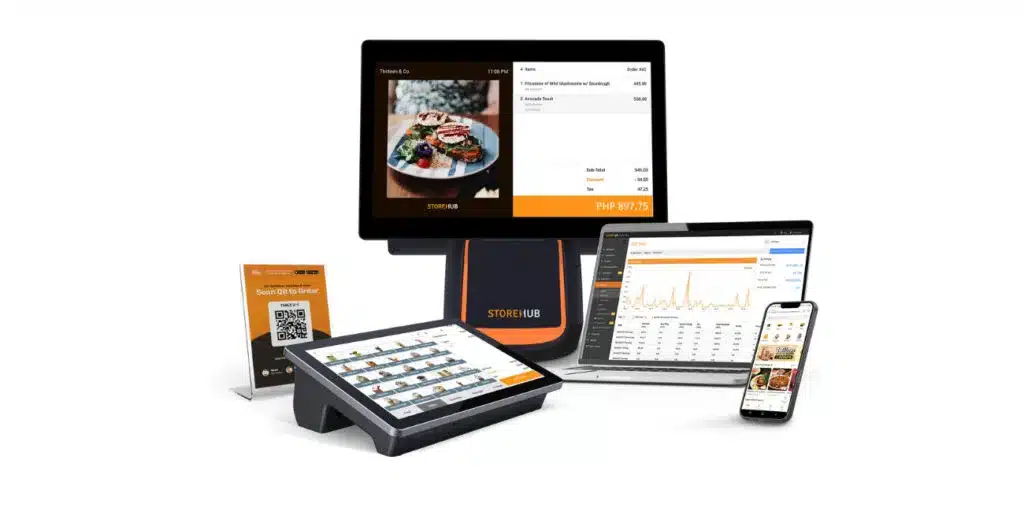
StoreHub is a comprehensive Point of Sales (POS) system that is tailored for small to medium-sized businesses, particularly in the retail and F&B sectors. It offers a range of features designed to streamline operations, enhance customer experience, and boost sales.
One of the key advantages of StoreHub is its user-friendly interface, which simplifies the onboarding process and daily operations for staff.
However, some users might find the subscription costs relatively high, especially for businesses with tight budgets. Additionally, while StoreHub offers extensive features, it may present a learning curve for less tech-savvy people.
Best for: Small to medium-sized food and beverage businesses, such as cafés, restaurants, and retail stores.
Who shouldn’t use: Large enterprises or businesses requiring highly specialized features.
Pricing: From ₱1,874 per month (billed annually).
Below are some of the StoreHub’s restaurant POS features:
- Sales Tracking: StoreHub provides tools for accurate sales tracking, helping businesses understand sales trends.
- Inventory Management: The system includes inventory management features to efficiently manage stock levels.
- Business Reporting: The reporting feature offers an in-depth business performance analysis, aiding strategic planning.
- Customer Relationship Management: StoreHub has tools to manage customer relationships and enhance customer experience.
| Strengths | Weaknesses |
|
|
Also read: StoreHub POS Review: Features, Advantages, and Considerations
7. Lightspeed
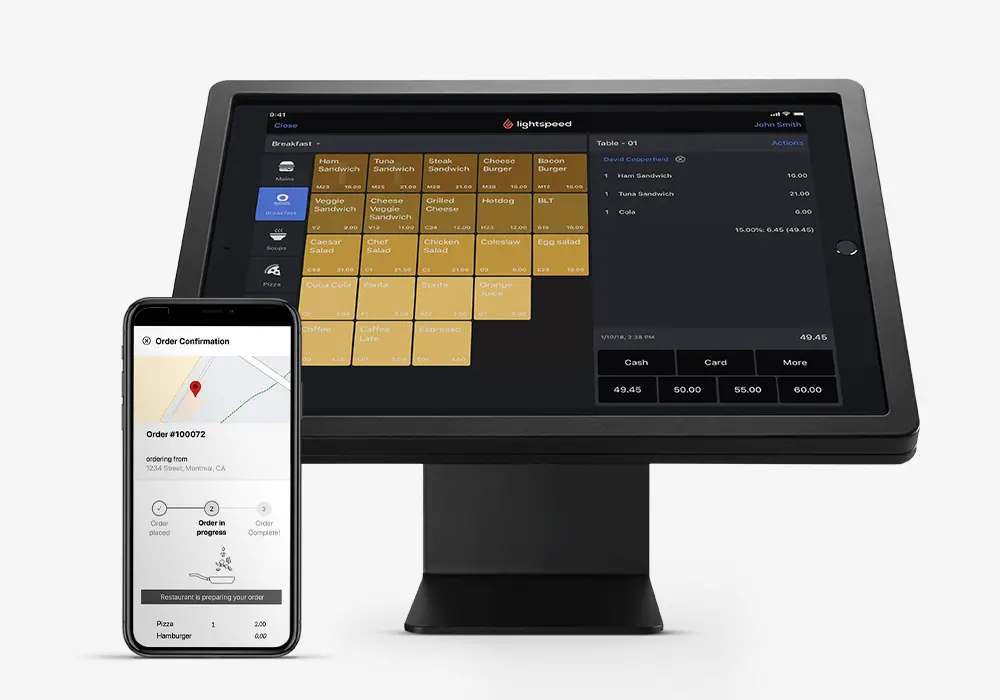
Lightspeed is a versatile Point of Sales (POS) system designed to cater to the needs of retail, hospitality, and e-commerce businesses. Key features include advanced inventory management, integrated eCommerce, employee management, and detailed analytics.
The main advantages of Lightspeed include its comprehensive inventory management, which supports complex product catalogs and seamless integration with online sales.
Furthermore, while Lightspeed is feature-rich, it might be more complex than necessary for small operations. In addition, users not experienced with advanced ePOS or tech-savvy may find Lightspeed challenging.
Best for: Food and beverage businesses expanding, those with large or complex inventories, and vendors focused on protecting profit margins.
Who shouldn’t use: Businesses looking for free plans, vendors needing an all-in-one POS terminal, or owners seeking low transaction fees.
Pricing: $69 per month
Here are some of the Lightspeed’s restaurant POS features:
- Inventory Tracking: Lightspeed offers advanced inventory tracking capabilities, allowing users to monitor stock levels in real-time.
- Customer Loyalty Feature: The system includes a customer loyalty feature to manage loyalty programs and retain customers.
- Multi-Store Capability: Lightspeed supports managing multiple locations, ideal for businesses with multiple branches.
- Payment Processing: The system offers various payment processing options, providing flexibility for customers during transactions.
| Strengths | Weaknesses |
|
|
8. UTAK POS
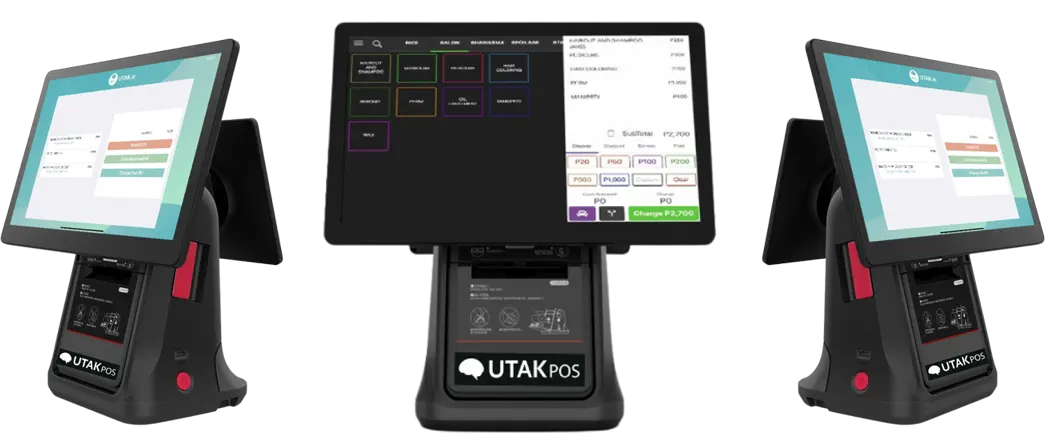
UTAK is an emerging Point of Sales (POS) system in the Philippines that caters specifically to food service industries. UTAK’s real-time analytics provide valuable insights into sales trends and inventory levels, aiding in better business decision-making.
However, a potential drawback is that UTAK POS may lack some of the advanced features in more established mobile POS systems, limiting its scalability for larger businesses or those with more complex needs.
Additionally, while customer support is available, it may not be as robust or extensive as some competitors offer.
Best for: Small to medium-sized enterprises in the Philippines looking for an affordable, tablet-based POS system.
Who shouldn’t use: Large-scale restaurants that need integration with food delivery apps or accounting software.
Pricing: From ₱2,333 per month (billed for six months).
These are some of the UTAK restaurant POS features:
- Sales Tracking: UTAK includes tracking features to help businesses analyze their sales performance.
- Customer Management: The system allows for effective customer data management to enhance service quality.
- Multi-Language Support: UTAK supports multiple languages, making it easier to use in various regions.
- Local Payment Support: The feature facilitates local payments, increasing customer convenience.
| Strengths | Weaknesses |
|
|
9. Toast
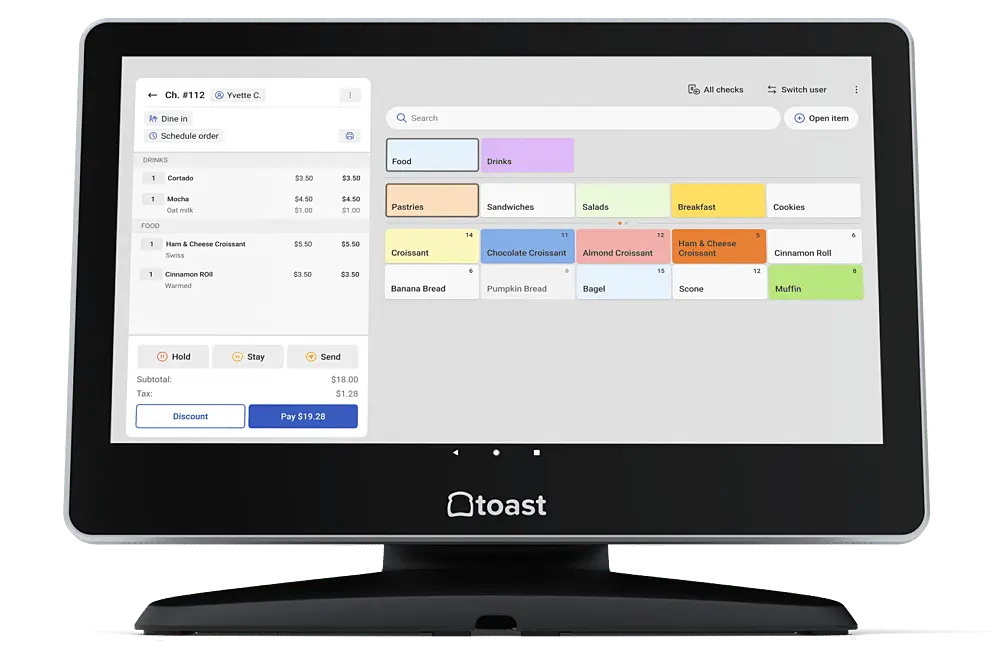
Known for its robust and restaurant-centric features, Toast offers an all-in-one platform that integrates order management, inventory tracking, customer relationship management (CRM), and comprehensive reporting.
The intuitive interface and seamless integration with kitchen display systems streamline order processing and reduce errors. Additionally, while Toast offers extensive features, this might result in a steeper learning curve for some users.
Best for: Full-service restaurants with complex operations, restaurants that onboard regularly, restaurants or bars with large inventories, and food businesses aiming to increase profits.
Who shouldn’t use: Small businesses with simple inventories, users relying heavily on customer support, or those with iOS hardware.
Pricing: Free – $69 per month.
These are a few of the Toast restaurant POS features:
- Inventory Management: Toast provides comprehensive inventory management tools to track ingredients and products efficiently.
- Customer Management: The system allows customer information management to improve customer experience and service.
- Loyalty Program Management: Toast includes features to manage loyalty programs, helping businesses retain loyal customers.
- Reporting & Analytics: The reporting and analytics feature provides valuable insights into business performance and sales trends.
| Strengths | Weaknesses |
|
|
10. Lavu
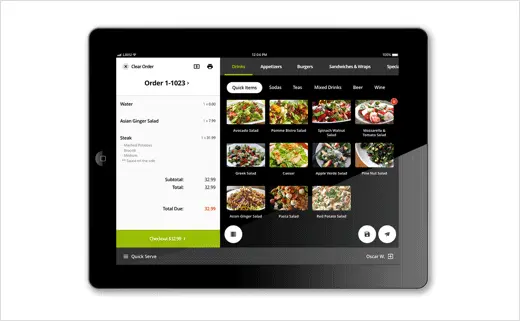
Lavu’s robust platform integrates order management, tableside ordering, inventory tracking, and detailed reporting, all within a user-friendly interface designed specifically for restaurant workflows.
While Lavu boasts a multitude of strengths, a few cons warrant consideration. Users have reported challenges with the onboarding process, citing complexities that may require additional time and resources for staff training.
Additionally, occasional print issues have been reported, which can disrupt service flow and customer satisfaction.
Best for: Small to medium-sized restaurants, bars, and cafés seeking a flexible, iPad-based POS system.
Who shouldn’t use: Restaurants that don’t use iOS devices, as this software primarily operates on it and needs internet connection.
Pricing: From $59 per month
Lavu’s restaurant POS features:
- Multiple Payment Options: Lavu supports various payment methods, including credit cards and mobile payments, providing flexibility for customers.
- Menu Interface: The system features an intuitive menu interface that allows easy navigation for staff and customers when placing orders.
- Inventory Management: Lavu includes inventory management tools that help track stock levels and ingredient usage in real time.
- Customer Loyalty Management: The system provides features for managing customer loyalty programs to enhance customer retention and satisfaction.
| Strengths | Weaknesses |
|
|
11. Revel 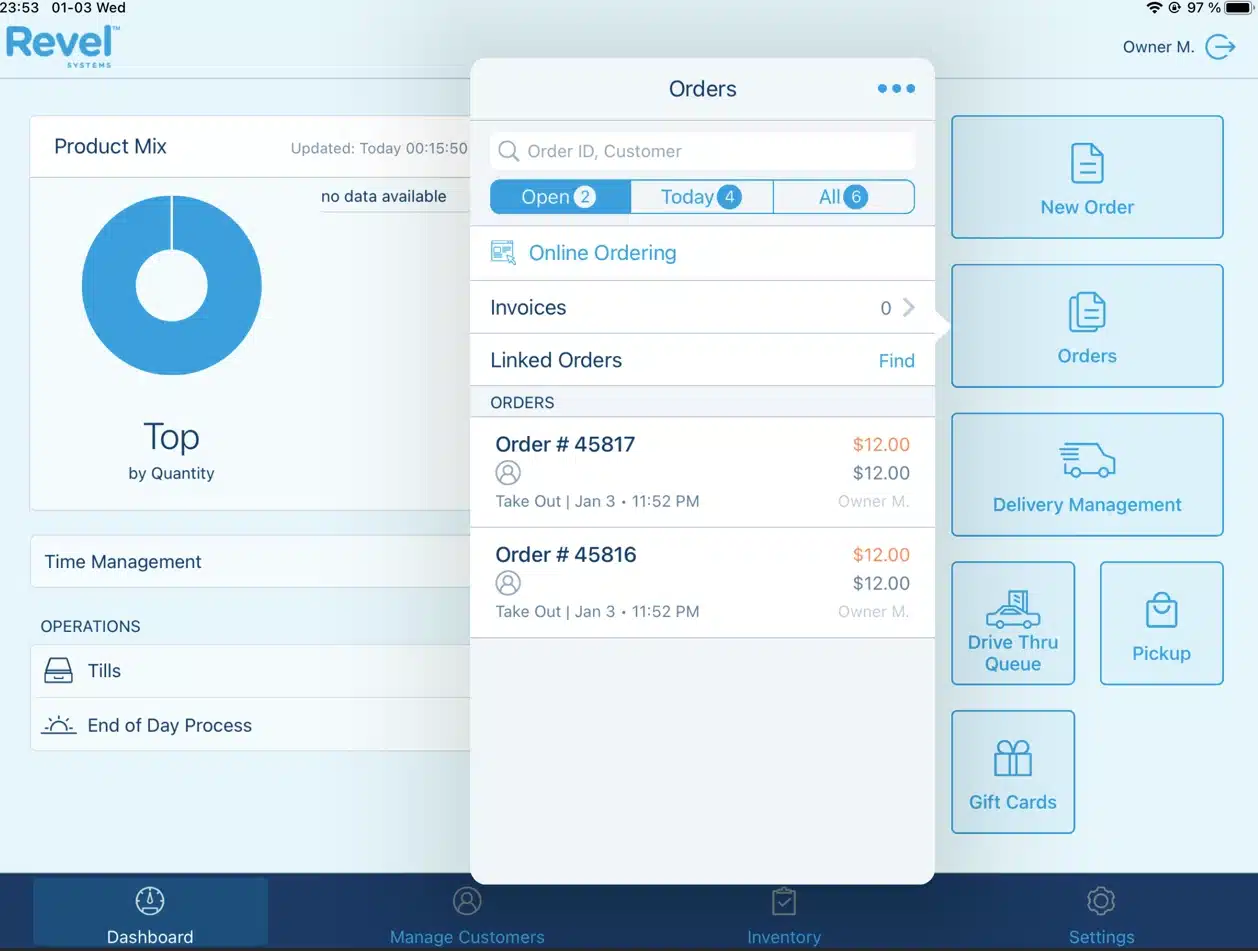
Revel Systems is a cloud-based Point of Sale (POS) solution designed primarily for the restaurant industries, including cafes. It offers a comprehensive suite of features that streamline operations, enhance customer service, and improve inventory management.
With tools for table management, real-time inventory tracking, and detailed sales analytics, Revel empowers business owners to make informed decisions based on accurate data.
One of the standout aspects of Revel Systems is its flexibility in payment processing, allowing businesses to choose the payment solutions that best fit their needs. Additionally, it supports multi-location management, making it an ideal choice for businesses with multiple branches.
Best for: Medium to large-sized restaurants, bars, and quick-service establishments needing advanced features.
Who shouldn’t use: Small businesses or startups with limited budgets.
Pricing: From $99 per month per terminal.
Revel’s restaurant POS features:
- Customizable Dashboard: Revel offers a highly customizable dashboard that allows users to tailor their interface according to their specific operational needs.
- Advanced Inventory Management: The system includes advanced inventory management tools that track stock levels, ingredient usage, and supplier information in real-time.
- Employee Management Tools: Revel Systems provides features for managing employee schedules, tracking performance, and handling payroll efficiently.
- Integrated Marketing Tools: The platform includes marketing capabilities that enable businesses to create promotions, email campaigns, and customer engagement strategies directly from the POS.
| Strengths | Weaknesses |
|
|
12. TouchBistro
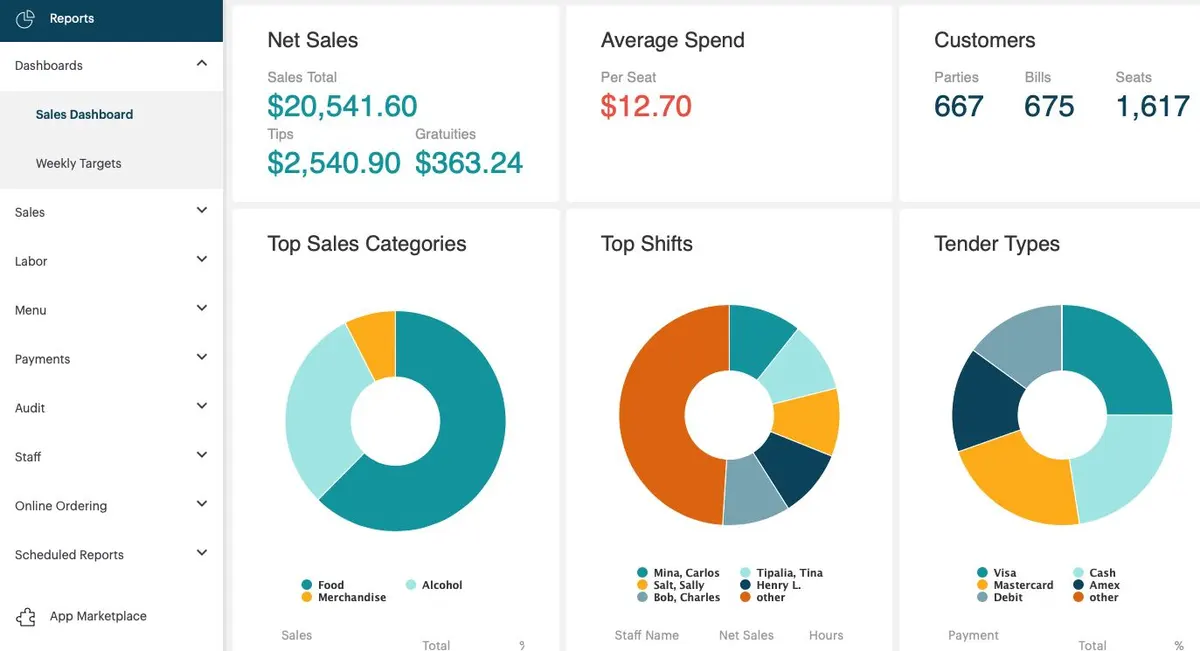
TouchBistro is a cloud POS software specifically designed for the restaurant industry, and it includes cafes, bars, and food trucks.
Key features include intuitive menu management, which allows restaurant staff to quickly add or modify menu items, and detailed inventory tracking that helps manage stock levels and understand profit margins for each dish.
TouchBistro also provides robust table management capabilities, enabling managers to design floor plans and easily allocate tables to guests, streamlining service during busy periods.
Best for: Small to mid-sized restaurants, bars, cafés, and quick-service venues seeking an intuitive, iPad-based POS system.
Who shouldn’t use: Large enterprises or establishments requiring extensive hardware options beyond iOS devices.
Pricing: From $69 per month for a single license.
TouchBistro’s restaurant POS offers the following features:
- Tableside Ordering: This feature allows servers to take orders directly at the table using mobile devices, improving service speed and accuracy.
- Menu Management: Users can easily customize their menus, adding images and descriptions to enhance customer appeal.
- Staff Scheduling: TouchBistro provides tools for managing staff schedules, allowing managers to efficiently allocate shifts and track hours worked.
- Integrated Payments: The system supports various payment methods, including contactless options, ensuring a seamless checkout experience for customers.
| Strengths | Weaknesses |
|
|
13. EPOS Now
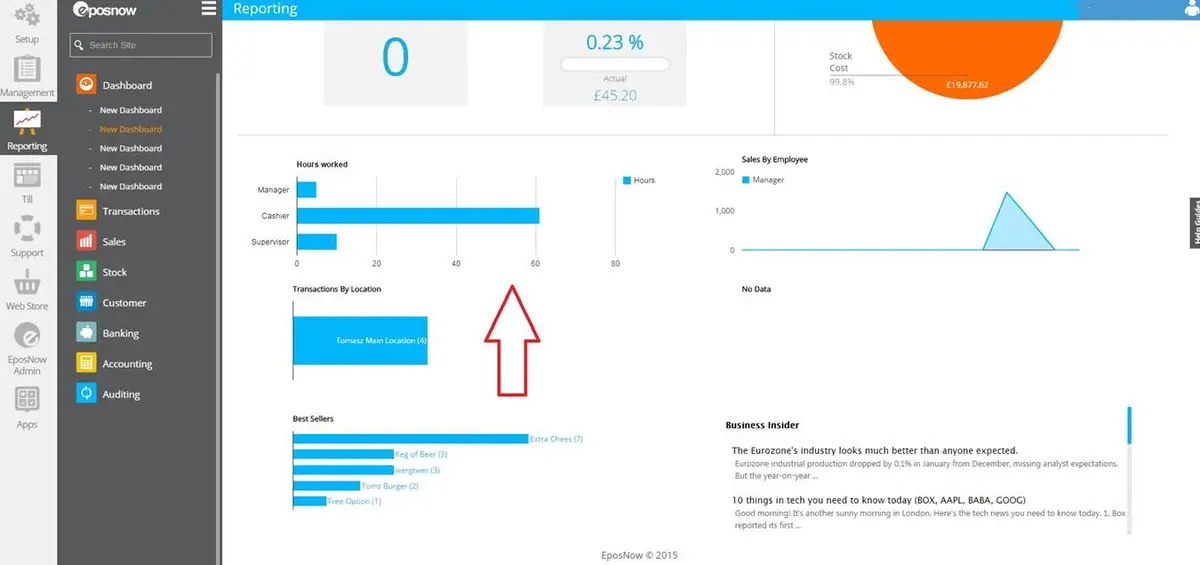
Epos Now is a cloud-based point of sale (POS) system that caters to the restaurant industry and provides a versatile solution for businesses of various sizes.
It features a user-friendly interface that can be operated on multiple devices, including iPads, Android tablets, PCs, and Macs.
Epos Now offers comprehensive tools for inventory management, customer promotions, and integration with e-commerce platforms, making it suitable for cafes, restaurants, and retail stores.
The system also includes features like customer loyalty programs and reservation management, which help businesses enhance customer engagement and streamline operations.
Best for: Food businesses with large inventories, those seeking low monthly costs, and restaurants opening a second branch.
Who shouldn’t use: Small businesses avoiding upfront costs, restaurants needing email marketing, or owners new to POS systems.
Pricing: $39 to $349 per month
EPOS Now’s restaurant POS features:
- Inventory Management: Epos Now offers robust inventory tracking capabilities, allowing users to monitor stock levels in real-time and manage reordering processes effectively.
- Customer Relationship Management (CRM): The system includes CRM tools that help businesses track customer interactions and preferences, enabling personalized marketing strategies.
- Multi-Location Support: Epos Now allows businesses with multiple locations to manage all their operations from a single dashboard, streamlining oversight and reporting.
- Sales Reporting and Analytics: Users can access detailed sales reports and analytics to gain insights into business performance and make data-driven decisions.
| Strengths | Weaknesses |
|
|
14. CAKE
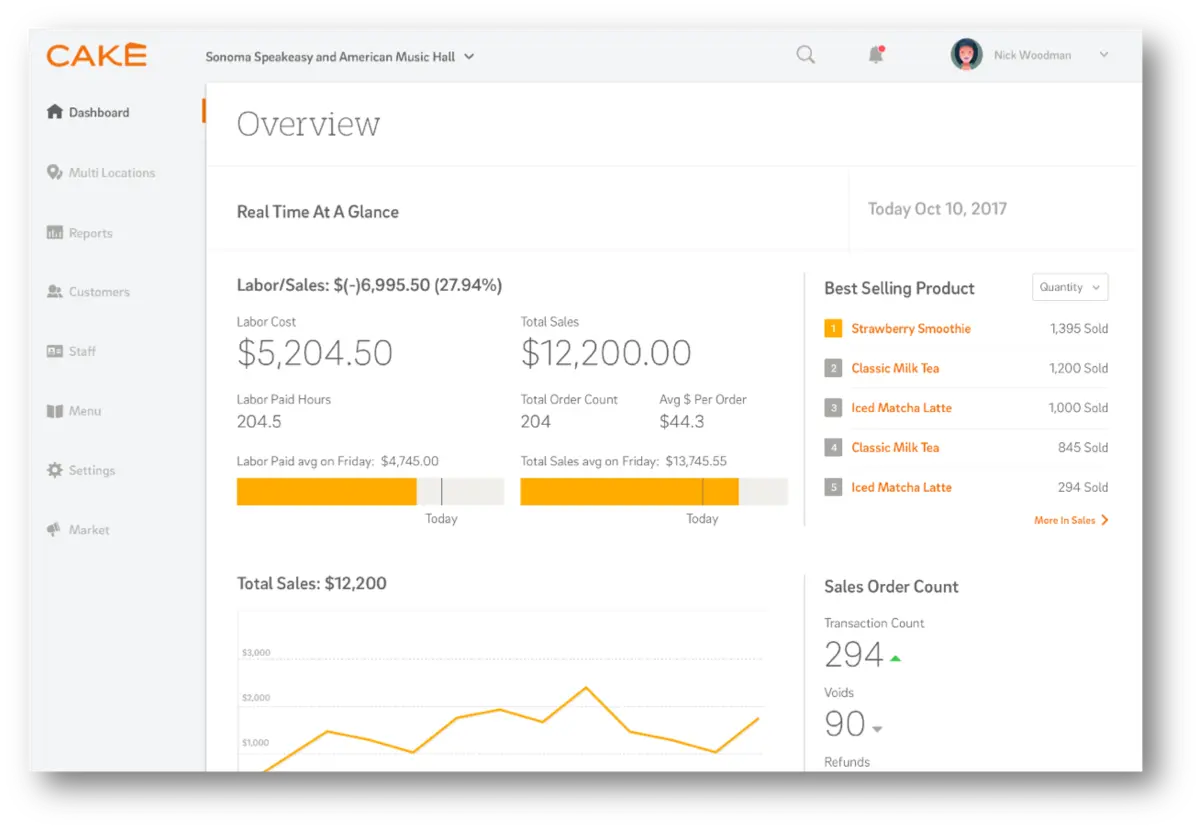
CAKE is a cloud-based Point of Sale (POS) system that offers a user-friendly interface that simplifies order management and enhances customer service.
Key features include integrated online ordering, curbside pickup, and tableside ordering, allowing restaurant staff to place and modify orders quickly.
CAKE’s payment cube supports various payment methods, including contactless options like Apple Pay and Google Pay, which streamline transactions and improve efficiency.
Best for: Restaurants of all sizes looking for a user-friendly, all-in-one POS system.
Who shouldn’t use: Businesses looking to avoid long-term contracts or upfront activation fees.
Pricing: Starts from $69 per month for one terminal.
Cake’s restaurant POS offers the following features:
- Online Ordering Integration: CAKE supports online ordering directly through the POS system, allowing restaurants to manage in-house dining and takeout seamlessly.
- Loyalty Programs: The system includes built-in loyalty program features that help businesses engage customers and encourage repeat visits through rewards.
- Real-Time Reporting: CAKE provides real-time reporting tools that give insights into sales trends, staff performance, and customer preferences for better decision-making.
- Curbside Pickup Management: This feature allows restaurants to manage curbside pickup orders efficiently, enhancing the customer experience during busy times.
| Strengths | Weaknesses |
|
|
POS System vs Cash Register: What’s The Difference?
When choosing between a cash register and a POS system, understanding their differences is key. Cash registers handle basic transactions, while POS systems offer advanced features like inventory tracking, reporting, and customer management. Here’s a comparison to help you decide which suits your restaurant best.
| Feature | Cash Register | POS System |
|---|---|---|
| Functionality | Basic transaction recording | Advanced order management, reporting, and analytics |
| Payment Processing | Limited to cash and card payments | Supports multiple payment methods, including digital wallets |
| Inventory Management | Manual tracking required | Automated inventory tracking and alerts |
| Reporting & Analytics | Minimal or no reporting | Detailed sales, customer, and performance reports |
| Order Management | Simple receipt printing | Integrated kitchen display and order tracking |
| Customer Engagement | No loyalty or CRM features | Built-in loyalty programs and customer relationship management |
| Scalability | Limited to single-location use | Supports multiple locations with cloud-based access |
| Cost | Lower upfront cost | Higher initial cost but long-term ROI through efficiency |
How to Switch Restaurant POS Providers
Thinking about changing your restaurant’s POS system? Before switching, there are important things to keep in mind to ensure a smooth transition.
Firstly, choose a new POS that works with most of the hardware you already have, like tablets or payment machines your servers currently use. However, sometimes your hardware may not be compatible, meaning you might need new devices from your new POS provider.
Also, check if your new POS can easily connect with software you already use, like accounting apps. Ensure the new POS integrates smoothly with your existing accounting or management software.
Before canceling your current POS subscription, make sure to transfer your menu data to the new system or download it. Creating your menu again from zero can take a lot of time, but you can avoid this hassle by planning ahead.
Training your staff is critical, especially if they’re comfortable with your current POS system. Consult your new provider for available training materials or sessions, and encourage employees to raise any concerns early on.
Finally, plan your switch during quiet hours or days. Avoid introducing a new POS during busy service times, as it might cause extra stress. Consider starting on your least busy day or bringing staff in during closed hours for focused training without distractions.
Buyer’s Guide: How to Choose a Restaurant POS System
An effective POS solution is crucial for restaurant operations. It facilitates seamless transactions and enables informed business decisions. Due to their unique operational needs, restaurants especially need specialized systems.
Unlike typical retail setups, restaurants must handle table reservations and link orders to tables. Additionally, Restaurant inventory management must closely track ingredient use and costs per dish.
What are the top restaurant POS system features to look for?
A quality restaurant POS platform will include specialized tools to meet the demands of food service operations. Below are some of the most important features to consider:
- Inventory Management: Keeps track of ingredient usage and current stock levels.
- Stock Alerts: Automatically notifies the team when supplies run low and need restocking.
- Customer Loyalty Programs: Lets you offer promotions, gift cards, and incentives to encourage repeat business.
- Customer Relationship Management (CRM): Safely maintains customer contact information (emails, phone numbers, etc.) for marketing campaigns.
- Employee Management: Tracks employee work assignments and shift hours.
- Table Management: Links orders to specific tables and tracks each table’s service status.
- Reservation Management: Allows your team to schedule and manage table bookings efficiently.
- Online Ordering: Enables customers to place online orders, which is especially helpful for quick-service environments.
- Payment Processing: Accepts various payment methods (cash, credit/debit cards, and contactless payments).
What restaurant POS hardware accessories do I need?

While the POS software handles most tasks behind the scenes, the right hardware can greatly improve efficiency during day-to-day operations. Here are some important hardware components for a restaurant POS system:
- POS Stands & Docks: Adjustable holders for the POS terminal, allowing staff to easily show the screen to customers and capture electronic signatures.
- Self-Service Kiosks: Standalone stations (with built-in receipt printers and card readers) where customers can place orders and pay independently, reducing the staff’s workload.
- Touchscreen Terminals: Tablet-based screens (such as an iPad) that offer a faster and more mobile alternative to a standard desktop POS.
- Portable Power Sources: Battery packs or mobile charging units keep tablets and card readers running without interruption during long service hours.
- Card Readers: Small devices that connect to tablets or smartphones to quickly process credit and debit card payments.
What is the Price of a Restaurant POS System?
In 2025, the pricing of a POS system for restaurants is influenced by several key factors:
-
Subscriptions for restaurant POS systems typically cost between $15 and $100 per month for a single terminal.
-
If multiple terminals are necessary, the cost can range from $29 to over $1000 per terminal, depending on the system’s features.
-
Transaction fees on card payments range from 1.5% to 3.5% per transaction. On average, US restaurants with a monthly revenue of $40,500 might pay about $1,012.50 in transaction fees each month based on the typical 2.5% fee rate.
-
The hardware components are priced separately. A basic setup including a terminal, cash drawer, and card reader can cost anywhere from $200 to $1,500, based on specific needs. Additional items like iPads or kitchen display systems can further increase the starting cost.
For small food businesses with simple POS needs, the upfront cost is approximately $200 for hardware and a monthly fee of around $15 for basic POS software. Affordable solutions are available.
For larger establishments or those requiring multiple terminals, the investment in hardware might range from $1,500 to $2,000+, plus about $150 per month for a multi-terminal software package.
How We Researched The Best Restaurant POS Systems
Choosing the right POS system for your restaurant can significantly impact your business operations and bottom line. Here’s a concise guide to help you make the best decision:
- Assess Your Needs: Understand your restaurant’s specific requirements. Consider factors like menu complexity, number of terminals needed, integration with other systems, and mobility options.
- Ease of Use: Opt for a user-friendly interface to minimize staff training time and errors during busy hours. Intuitive design and customizable layouts can streamline order processing.
- Features and Functionality: Look for features tailored to the restaurant industry such as table management, split checks, and modifiers. Integration with online ordering and delivery platforms is also crucial in today’s digital landscape.
- Reliability and Support: Choose a POS system with a solid reputation for reliability and responsive customer support. Downtime can be costly, so ensure there’s reliable technical assistance available when needed.
- Scalability: Consider your restaurant’s growth potential. A scalable POS system should accommodate expansions regarding additional terminals, locations, and features without major disruptions.
- Cost Consideration: Evaluate upfront costs and ongoing fees, including hardware, software licenses, and transaction fees. Ensure the system offers good value for your investment over time.
By carefully considering these factors and bridging them with your restaurant’s unique needs, including the integration of a retail Point of Sale system, you can confidently select the right POS system to enhance efficiency and customer satisfaction.
Conclusion
Choosing the right POS system can streamline your restaurant operations, enhance customer service, and boost your bottom line. With the right POS system, managing your restaurant can become a much more efficient and enjoyable experience.
HashMicro POS Restaurant offers a tailored POS system that stands out in the dynamic landscape of the Philippines’ restaurant industry.
Our POS software is designed with a comprehensive suite of all-in-one tools to streamline operations, allowing you to focus on delivering exceptional dining experiences.
Click the banner below to request a free demo and witness how our solution can elevate your restaurant’s success.
FAQ Restaurant POS System
-
What are the different types of POS systems?
Several types of POS systems exist, including traditional POS systems that use hardware, mobile POS (mPOS) that operate on tablets or smartphones, cloud-based systems that store data online, and self-service kiosks.
-
Can restaurant POS software integrate with accounting software?
Yes, many restaurant POS systems can integrate with accounting software, allowing for seamless data transfer that streamlines financial management, reduces manual entry, and enhances reporting accuracy.
-
What is a POS system for restaurants?
A POS (Point of Sale) system for restaurants is a software and hardware solution designed to manage sales, orders, and payments efficiently. It integrates various aspects of restaurant operations, such as order taking, inventory management, and reporting, into one seamless platform.
-
What is the Best Restaurant POS System?
The best restaurant POS system depends on your specific business needs, such as the size of your restaurant, budget, and required features. However, HashMicro’s Restaurant POS System is widely recognized as a top choice due to its comprehensive features and flexibility.
-
What is the difference between a POS system and a POS terminal?
A POS system encompasses the entire setup for processing sales, including software and hardware, while a POS terminal specifically refers to the hardware device used to complete transactions, such as a card reader or cash register.



